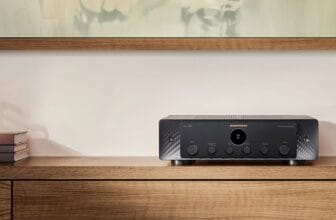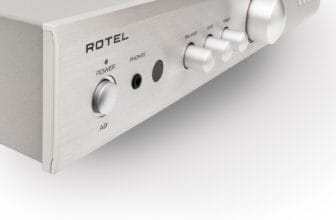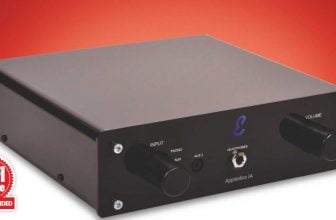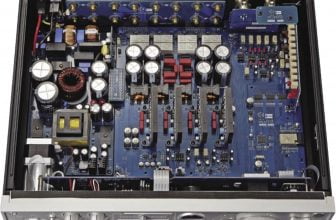Copland CSA 70 Review
Hot on the heels of its tube hybrid integrateds comes this altogether cooler solid-state amplifier from Danish brand Copland. It packs on the style while also packing a punch. Read our Copland CSA 70 Review.
Review: Ken Kessler Lab: Paul Miller
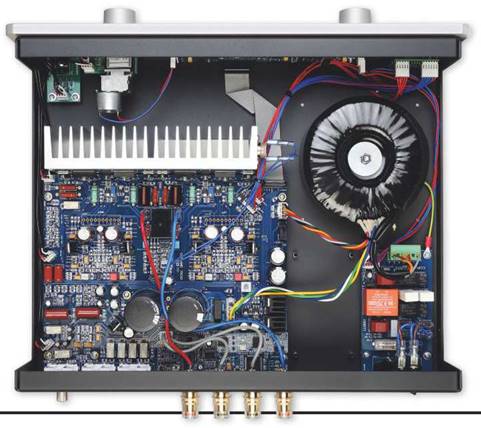
Rated at 7OW/8ohm
Made by: Copland, Copenhagen, Denmark
Supplied by: Absolute Sounds Ltd
Telephone: 0208 971 3909
Web: www.copland.dk; www.absolutesounds.com
Nothing causes more consternation than a product seemingly 180 degrees at odds with a company’s core philosophy, whether hi-fi, cars, watches, what-have-you. Audio Research dealt with the repercussions of its first solid-state amp_ but an all-transistor amp from the equally tube-centric Copland? Not its first – these were the mid-’90s CSA8/CSA18 – so the CSA70 probably won’t cause too much of a ruckus despite the absence of bottles.
Either way, like Japan’s sublime Air Tight and other mystifyingly low-key brands, Copland merits greater fame [see boxout, p59]. Undoubtedly, this unit could serve perfectly as an intro to the brand and is ideally suited to those considering new hardware at mid-level. Offered in silver or black, an MM phono stage wisely included, it lacks nothing but balanced inputs, while the Bluetooth/Wi-Fi option – not present in the review sample – further broadens its appeal to those weaned on tablets and mobile phones.
BRICK BY BRICK
There’s a degree of future-proofing too, the spec including pre- and line-outs so you can expand it with a second amp, upgrade a stage at a time, incorporate it into a home cinema, or fit a tape deck. It’ll host digital sources via coax, Toslink or USB while its remote control [see p61] will also deal with Copland’s legacy CD players.
The CSA70, however fully-loaded it may be, is so sensible that it’s worthy of being described as being as Danish as Lego. Its styling – clearly modelled on Copland’s larger CSA100 and CSA150 hybrid tube/ transistor amps [HFN Aug ’20 and Jun ’21] – is so clean as to be exceptionally easy on the eye, such that anything sitting next to it looks virtually rococo.
Functionality? Beyond reproach save for the aforementioned lack of balanced XLR inputs, but that’s hardly a fatal omission. Under the bonnet [see inside picture, below], the transistor output stage bears some similarity with that premiered in the CSA100 and ‘150 although their triode preamp stages are traded here for a wide- bandwidth solid-state circuit. The digital section is tailored to the CSA70 too, with a Cirrus rather than ESS DAC.
Across the front, the CSA70 presents a face that’s nearly self-explanatory. I say ‘nearly’ because the labelling on the rotary at the lower left-hand corner may seem arcane, but not to anyone who uses digital sources. As this is relatively affordable, it might find its way into the systems of hi-fi novices, who will need to refer to the owner’s manual, but the rest of you will immediately decipher the settings to represent Bluetooth, Coax, Optical 1 and 2, and USB, while three LEDs below indicate its operational status.
LIGHT MUSIC
A large rotary on the left of the amp’s fascia selects the sources while level is set by a motorised, analogue control on the far right. In the middle is an ‘early iPod’- styled display indicating the selected input. It lights up, clockwise, for standby (a red button to the lower right of the display accesses this state of rest, which is – but of course! – labelled ‘ST.BY’), phono (a ‘P’), and three line inputs indicated by numbers. Selecting a digital source (‘D’) lights up the LEDs in the lower left corner, but the ‘D’ only illuminates when the optional Bluetooth module is present. Lastly, there is a 6.35mm headphone socket, which mutes output to the loudspeakers.
A mix of clarity and abundance, the feature-packed back panel and an IEC three-pin mains socket.
LIKE DANISH PASTRY
There is no drama at all with the CSA70. It worked perfectly from the start, and my intuition didn’t fail me in figuring out the connections. Assorted inputs aside, I was more interested in determining the overall character of the unit, so I stuck with CD via somehow maintains the Scandinavian obsession with minimalism. Despite the plethora of socketry, it, too, is self- explanatory to the seasoned audiophile, with RCA phono sockets on the left for pre-out/line-out, next to a pair for phono with an earthing post above, followed by three sets of sockets for the line inputs.
‘I wasn’t expecting to be captivated so easily’
Next to these is a post for the Bluetooth aerial and a reset button, which come fitted whether or not the optional internal module has been purchased, followed by digital inputs for USB, coaxial and two optical. Above them are multi-way speaker binding posts, plus the main on/off power switch the optical input and the MM phono stage fed with Decca and Ortofon cartridges. The lack of an MC input is easily addressed if the CSA70 leaves you strapped for cash by any number of sub-£ phono amps.
Two piles of records have forced me into rediscovering formats I’ve been neglecting: demo LPs and 10in/12in 45rpm singles. The former promises superlative sound, which is their raison d’etre. The latter delivers superior sonic events because a single four- to-10min track spread over that much vinyl real estate usually means grooves that are wider and deeper.
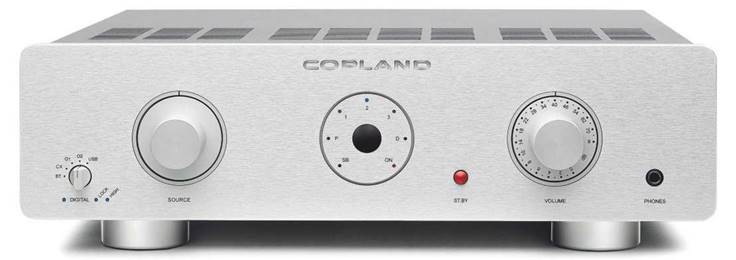
ABOVE: Precision-milled rotaries select source and volume with a smaller control stepping through the digital input options. Central dial carries the IR ‘eye’ and input/status LEDs
Whatever the reason for large format singles sounding so good, Kirsty MacColl’s rendition of The Kinks’ ‘Days’ on a 10in single [Virgin KMAN2] showed me that the CSA70’s phono stage can deliver emotional impact nearly as well as the circa outboard phono stages I’ve been trying over the past few years. It wasn’t just the warmth in the vocals, although that tells you this amplifier was clearly voiced by designers more at home with the sound of valves, but the cavernous soundstage.
This track enjoyed a wall-to-wall spread, whether heard via small box-type speakers or entry-level panels, the latter surprising me by producing more bass energy than I expected. This was confirmed by the lower registers on a ‘normal’ LP, the remastered edition of Warren Zevon’s Stand In The Fire [Asylum/Run Out Groove ROGV-116]. This live album is one of those rarities where the sound is as pristine as a carefully-crafted studio recording. ‘Bo Diddley’s A Gun Slinger/Bo Diddley’ had bass and percussion so rich and abundant that even LS3/5As sounded weighty. It struck me again with the opening moments of ‘Roland The Headless Thompson Gunner.’
CHEER LEADER
What this album also provided were audience sounds – the cheers when Zevon launches into ‘Werewolves Of London’ – and a sense of the concert hall space. No ‘Rice Krispies’ applause, just a wave of adulation as authentic as the crowd noises from that yardstick for live recordings: any version you care to choose of The Allman Brothers’ Live At Fillmore East. Better still, Zevon’s edgy, often acidic vocals were uncoloured, speaking volumes for the feed to the desk and the quality of the microphones, despite this remastering on vinyl coming from the 2007 CD masters.
Despite the lack of prolificacy, the back catalogue boasts more than its fair share of riches for such a dearth of models. My personal faves are based on user experience; thus I lust for assorted models, especially the CTA506 power amp [HFN Jun ’12]. An early showcase for the KT120 tube, it married real power with unbelievable delicacy, a Copland stock-in-trade. Its ‘grid-cooling’ front panel, reminiscent of 1930s radios, lives on in the equally-retro CTA408 [HFN Apr ’19], which uses KT150s. My choice as a future classic? The CTA401 integrated amp of 1990 – the CSA70’s EL34-equipped great-grandpappy.
We should be long past the CD-vs-LP schism that caused more than a few ulcers in the audio biz, but if you hate CD, skip these paragraphs. I simply couldn’t believe how visceral was the sound of another live album, Nina Simone’s The Montreux Years [BMG BMGCAT461DCD]. As this collection is assembled from five gigs spanning 22 years, the fun was following along with the liner notes to hear if the CSA70 could convey the subtle changes, and not just in the natural aging of this singer’s distinctive voice. Which it did, with ease.

ABOVE: MM phono is joined by three line ins on RCAs, a fixed line out and variable preamp out and single sets of 4mm speaker terminals. Digital inputs include coaxial, two optical and USB. The optional Wi-Fi/BT streaming adapter is also included here
So open and clear was the replay that I started to wonder about, of all things, the prices of high-end equipment. Here was an ‘affordable’ integrated amp with phono, line and digital inputs – enough to handle a generous eight sources even without the Bluetooth module – and ample grunt, great looks, amazing build quality, full remote, and pre/ line outs, for less than some would pay for a metre of interconnects.
BODY AND SOUL
The CSA70 is not without rivals, the Exposure 3510 [HFN Nov ’21] being an obvious alternative, but it kept pulling out the surprises. And yet it shouldn’t have, because I am no stranger to Copland electronics. I just wasn’t expecting to be captivated so easily, the most immediate seduction being Willy DeVille’s 1989 masterpiece, Victory Mixture [Wagram Music 3354386].
What this presented as a challenge to the CSA70 was that distinctive, growly voice, along with crystalline backing from Dr John on piano, as well as other New Orleans luminaries. Let’s dispense with my bias: long-term readers know that I rate DeVille in my all-time Top 10 vocalists. Having just sat through all three CDs in a fabulous retrospective and wallowed in Miracle, I had to remind myself that Victory Mixture might have even been a better album.

LEFT: Copland’s rubber-edged RC-102A system remote caters for its legacy CD player and, for the CSA70 amp, offers standby and volume plus input selection
This LP is all about feel and expression, as soulful as anything to come out of the Stax or Volt record labels, and it presents DeVille as a stylist of unique ability. I usually rail against attributing anthropomorphic values to hi-fi hardware, but the CSA70 succeeded in impressing upon this listener not just the innate Latin flavour to everything DeVille performed – Copland could rename it ‘Pablo’ or ‘Manuel’ and it would be apt – but an atmosphere so utterly redolent of the Big Easy that I suddenly got a craving for some piping-hot gumbo.
Back on earth, I dug out a torture test, the exquisitely produced if blandly named Stereo 35/MM from Command [RS 631 SD], a showcase for 35MM magnetic film recording. Ten seconds into ‘Of Thee I Sing’, the strings so sweet and real, I had to shake my head at the injustice of this not being the global best-seller.
VERDICT
LAB REPORT
Comparing this 70W/8ohm-rated CSA70 with the 100W/8ohm CSA100 [HFN Aug ’20] is not especially instructive for, despite the similar On Semiconductor-based output stage(s), the latter has a bigger PSU and tube-centric preamp stage that largely sets the ‘tone’ of the product. So the CSA70 is a distinct, standalone amp in the range, capable of delivering 2x90W/8ohm and 2x140W/4ohm with sufficient headroom to sustain peaks of 110W, 206W, 352W and a full 475W (21.8A) into 8, 4, 2 and 1ohm loads, respectively [see Graph 1, below]. Add to this fine load tolerance a usefully low 0.01-0.07ohm output impedance and response that’s flat to -0.3dB from 1 Hz-20kHz (and -1.9dB/ 100kHz). THD is held to within 0.003-0.004% from 20Hz-1kHz over 1-50W/8ohm, increasing to 0.04%/20kHz. Gain is more than typically required at +42dB and the A-wtd S/N ratio only slightly below average (white noise, not hum) at 83dB (re. 0dBW).
Measured via its fixed line output (which has a high 1 kohm source impedance) the CSA70’s digital stage employs a WM8740 DAC in place of the ESS9018 used in its other amplifiers. A 0dBFs digital input yields a 1.9V output, a respectable 104.8dB A-wtd S/N ratio and bass/midband distortion that falls to a minimum of just 0.0002% over the top 30dB of its dynamic range. This increases to a minimum ~0.001% at 20kHz [see Graph 2]. Jitter is squeezed to ~250psec while the limited 7dB stopband rejection is traded for greatly reduced ringing on transients – all this defined by the slow roll-off linear phase digital filter (the CSA100 uses a fast roll-off linear phase filter). The responses roll away to -2.1dB/20kHz, -4.7dB/45kHz and -6.1dB/90kHz with 48kHz, 96kHz and 192kHz digital files, respectively. PM
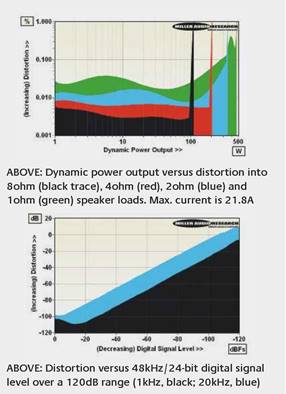
SPECIFICATIONS
| Continuous power (<1% THD, 8/4ohm) | 90W / 140W |
| Dynamic power (<1% THD, 8/4/2/1ohm) | 110W / 206W / 352W / 475W |
| Output imp. (20Hz-20kHz, Line/Amp) | 1.03kohm / 0.011-0.068ohm |
| Freq. resp. (20Hz-20kHz/100kHz) | + 0.00 to -0.25dB/-1.9dB |
| Digital jitter (USB / S/PDIF) | 200psec / 250psec |
| A-wtd S/N ratio (DAC/Amp) | 104.8dB (0dBFs) / 82.9dB (0dBW) |
| Distortion (DAC, 0dBFs/Amp, 0dBW) | 0.0005-0.0008%/0.0027-0.038% |
| Power consumption (idle/rated o/p) | 21W / 275W (1W standby) |
| Dimensions (WHD, each unit) | 435x135x370mm / 13kg |


